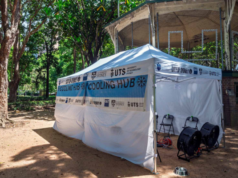A future with battery-free wearable technologies and buildings powered by invisible power sources could soon be a reality thanks to a ground-breaking new discovery in solar technology by Australian scientists.
Researchers from Queensland University (UQ) have developed a new kind of solar cell – the technology inside solar panels that captures the sun’s energy and turns it into electricity. The discovery may lead to the development of a ‘next generation’ of flexible ‘skin-like’ solar arrays.

A UQ team have developed quantum dot solar cells that can be made into thin,
flexible films and used to generate electricity even in low-light conditions
Current solar cells are made from monocrystalline or polycrystalline silicone that is attached to or melted onto solar cells. The QT solar cells are based on a new class of quantum dots – manmade nano-sized crystals that can transfer electrons and electrical charge between one another when exposed to sunlight.
Solar cells containing quantum dots have been a hot topic of research in recent years with scientists making considerable progress creating photovoltaic quantum dot cell prototypes. However, previous iterations have lacked the electrical conductivity to be suitably scaled for production.
The need to reduce global carbon emissions and find clean renewable energy sources has resulted in a worldwide race among energy scientists to develop solar quantum dot cells with an electrical conductivity high enough to be commercially viable. The UQ cells remain a front runner because they are 25 per cent more energy-efficient than the previous best quantum dot cell.
In testing the cells, UQ researchers led by Nano Materials Centre Director Professor Lianzhou Wang, set a world record for the conversion of solar energy to electricity raising the quantum dot energy efficiency rate conversion of sunlight from 13.4 to 16.6 per cent.

Furthermore, the quantum dot cells are considerably cheaper to produce than silicone-based solar cell technology and can be used to capture light indoors – something conventional solar cells can’t do very well.
“This new generation of quantum dots is compatible with more affordable and large-scale printable technologies,” Professor Wang said.
“The near 25 per cent improvement in efficiency we have achieved over the previous world record is important. It is effectively the difference between quantum dot solar cell technology being an exciting ‘prospect’ and being commercially viable,” he said.
The exciting next step for the UQ team is to achieve a 20 per cent efficiency similar to that achieved by current rooftop solar cells. It might then be possible to develop an array containing quantum dot technology, which could easily power vehicles, buildings and even wearable devices.
It’s likely such an array would be much more versatile than one made from the rigid crystalline or more flexible amorphous solar cells currently in use. For example, it could be sprayed onto the hard surfaces of buildings as a renewable power source to create a virtually invisible electricity-producing skin.
UQ Vice-Chancellor Professor Peter Høj said the technology is a step towards reducing global carbon emissions. “The world needs to rapidly reduce carbon emissions and this requires us to invest much more in research to improve existing energy-generation technologies and develop entirely new ones,” he said.
“Harnessing the power of fundamental technological and scientific research is a big part of this process.”













